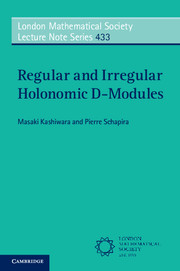Introduction
Published online by Cambridge University Press: 05 May 2016
Summary
This book develops the contents of a series of lectures given at the Institut des Hautes Études Scientifiques in February and March 2015 (see [KS15]), based on [Ka84], [DK13] and [KS14]. They are addressed to readers familiar with the language of sheaves and D-modules, in the derived sense.
As announced in the title, the subject of this book is holonomic D-modules. The theory of D-modules appeared in the 1970s with the thesis of [Ka70] and Bernstein's paper [Be71]. However, already in the 1960s, Mikio Sato had the main ideas of the theory in mind and gave talks at Tokyo University on these topics. Unfortunately, Sato did not write anything and it seems that his ideas were not understood at this time. (See [An07, Sc07].)
A left coherent DX-module on a complex manifold X is locally represented by (the cokernel of) a matrix of differential operators acting on the right. Hence, D-module theory is essentially the algebraic study of systems of linear partial differential equations. It seems that algebraic geometers were frightened by the non-commutative nature of the sheaf of rings DX, and it may be the reason why one had to wait untill the 1970s until the theory appeared. But once one realizes that the ring DX has a natural filtration (by the order of the operators) and that the associated graded ring is commutative, it is not too difficult to apply the tools of algebraic geometry to this non-commutative setting. In particular, one can define the characteristic variety char(M) of a coherent DX-module, a closed C×-conic complex analytic subset of the cotangent bundle T∗X and a fundamental result of the theory is that this variety is coisotropic (or involutive). Partial results in this direction (involutivity at generic points) were first obtained by Guillemin, Quillen, and Sternberg [GQS70]. The general case was obtained later by Sato, Kawai, and Kashiwara [SKK73], using tools of microlocal analysis such as microdifferential operators of infinite order. Then Gabber proposed a purely algebraic proof of this result in [Ga81], and there is also now another totally different proof based on the involutivity of the microsupport of sheaves on a real manifold (see [KS90]).
- Type
- Chapter
- Information
- Regular and Irregular Holonomic D-Modules , pp. 1 - 6Publisher: Cambridge University PressPrint publication year: 2016



